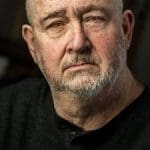Michael Steinberg
Michael Steinberg
 Corporate and editorial photographer Mike Steinberg was teaching Physics when chance put a camera in his hands and sent him to St. Lucia.
Corporate and editorial photographer Mike Steinberg was teaching Physics when chance put a camera in his hands and sent him to St. Lucia.
Many successful pros discover photography early in their teens and never look back. It’s often like a high school love affair that evolves into a life-long marriage. Corporate and editorial photographer Michael Steinberg followed a very different path. Science was his first love. He earned his BS in Chemistry at Case University, and taught Physics for two years before war, love and fate intervened.
‘My entire life in photography has been a series of coincidences,’ he laughs. ‘It’s total serendipity. If anything had been different, I would have been a chemist or a teacher. But I have no regrets. Absolutely.’
The Vietnam War was one factor that changed Mike’s plans; another was the fact that he got married soon after college. He and his wife Susan both thought the Peace Corp sounded better than the rumble in the jungle. They enlisted together, planning to share their hardships in some harsh part of the world. Instead, the Peace Corp assigned them to be teacher trainers on the idyllic Caribbean Isle of St. Lucia.
‘It’s embarrassing,’ says Mike. ‘We didn’t ask for it. We didn’t even know you could go there.’ On the way to St. Lucia, their group stopped at the duty free port in Barbados, where everybody, including Mike, bought a camera. ‘I had never owned one in my life,’ he says, ‘But how can you spend two years in the Caribbean without a camera?’
Photography quickly became a passion that Mike wrote home about. His father-in-law had an enlarger shipped to them on the island, and it wasn’t long before Mike set up a little darkroom in the kitchen of his cottage. He was still planning to earn a doctorate in Chemistry at the end of his Peace Corp service but as the photographic fates would have it, the grad school lost Mike’s acceptance letter, and his slot was no longer open when he returned to the States. It was at that point that he launched his professional career by getting himself hired as a staff shooter for a Cleveland newspaper.
Now a veteran of more than three decades behind the lens, Mike still does editorial work but finds that corporate assignments offer more freedom of expression. He has photographed annual reports for a wide-range of blue-chip clients including Eaton Corporation, Ohio Bell, Timkin, Diedold, and Reliance Electric. Also well-known for his medical photography, he has worked with most of the most major hospitals in the Cleveland area, where he lives. His editorial photography is represented by the prestigious Black Star cooperative, and has appeared in top publications such as Forbes, Newsweek and Time.
Mike’s movement away from photojournalism reflects his feeling about the difference between capturing a moment and expressing a vision. ‘For me, the point is not just taking the picture, but creating an image. There have always been two kinds of photography. The people who do photojournalism or events are capturing a moment, and they’d better not alter it. Photographers who do studio work put the pieces together and make the moment themselves. It’s more like putting your imagination in front of other people. Now, with digital, the two types of photography are kind of blending together.’
Mike’s portraits of animals at the Cleveland Zoo show how he heightens reality to express his vision. ‘I’ve always wanted to photograph unusual animals, but to do it my way, using lights and Photoshop to exaggerate their pose, their power, their personalities, but without trying to humanize them,’ he says.
Mike also has some amusing stories about working in close quarters with cantankerous rhinos, lemurs and crocs. ‘Rhinos are very dangerous and I think a photographer was killed by one at the Cincinnati Zoo. But they’re not dangerous for the reason people think. They have terrible eyesight, and they’re afraid of everything. This baby rhino weighed 1,000 pounds but was so scared by my light-stand that she tried to climb over metal bars to get away.’
When he tried to shoot crocs, they opened wide and charged in his direction. ‘Crocodiles are the only animal I couldn’t shoot at the zoo,’ he says. ‘Every time I put the camera up to cage, I had a croc launch itself at me, and they can jump a lot higher than you think. They looked at me as a piece of meat, and they were all hungry.’
But it was the cute little lemurs who gave him the worst headaches. ‘I love the way they have primate eyes in dog-like faces,’ he says. ‘But lemurs are among the loudest animals on the planet, and if there’s one thing I’m sensitive to with animals (other than being bitten or killed), it’s loud noises. I’d be in there with the lemurs, setting up lighting and waiting for the right expression, and they’d all be going off like air-raid sirens about three feet away from my ears.’
Mike is looking forward to teaching at the Digital Photo Academy because he knows the students in his workshops will be motivated and eager to improve their skills. ‘People sign up for these workshops because they love photography. No one will be there just to get an easy A,’ he says. ‘I want to help them do two things: find their vision and express it. Where I have the most fun is in pushing people to try to new things, to open themselves up, even if it means making a mistake. The only thing I have to tone down is that I have two completely conflicting opinions about photography. I believe it’s totally subjective but at the same time I have very strong opinions about what I like and don’t like.’
Call Digital Photo Academy at 1 877 372 2231. Lots of people seem to hang up if our welcome recording comes on instead of a live voice, but we promise to return your message within a day or two if you leave one with your name and number. It would be even better if you included your e mail address as well as the date and city of the class you are considering. If leaving a voice mail message is not your thing, please email us at DPAbooking@digitalphotoacademy.com or Richard@digitalphotoacademy.com.





Cheryl Neal
“Good morning Michael! Thank you so much for the class yesterday! Your patience, thoroughness, and professionalism are outstanding! I learned more in this class than in a previous two classes combined I had taken the past two years!!
Thanks again.”
-Cheryl Neal
Bill Indursky
“I had a great time yesterday taking pictures at the University Circle and discussing with you about composition and post processing. Composing shots with a broad viewpoint has always been my problem area, and I believe I have learned quite a few things that would help me going forward. The time you spent on Lightroom was also very valuable and I have tried to utilize those tools while post processing the shots I took yesterday.”
– Soumen Bhattacharya
Bill Indursky
“Alex, this class was fantastic. It rivaled any of the workshops I recently took at the Palm Beach Photographic Centre. For example, many of the teachers there placed an emphasis on impressing the students. You on the other hand, put the emphasis on explaining and teaching. I really learned a lot from you.”
– Ernie Pisciotti
Bill Indursky
“I was in your sports photography session two weeks ago that went to Gymnastics World. I really learned a ton from your session. I mean an absolute ton!”
– Mike Murray